Globe - Latitudes & Longitudes
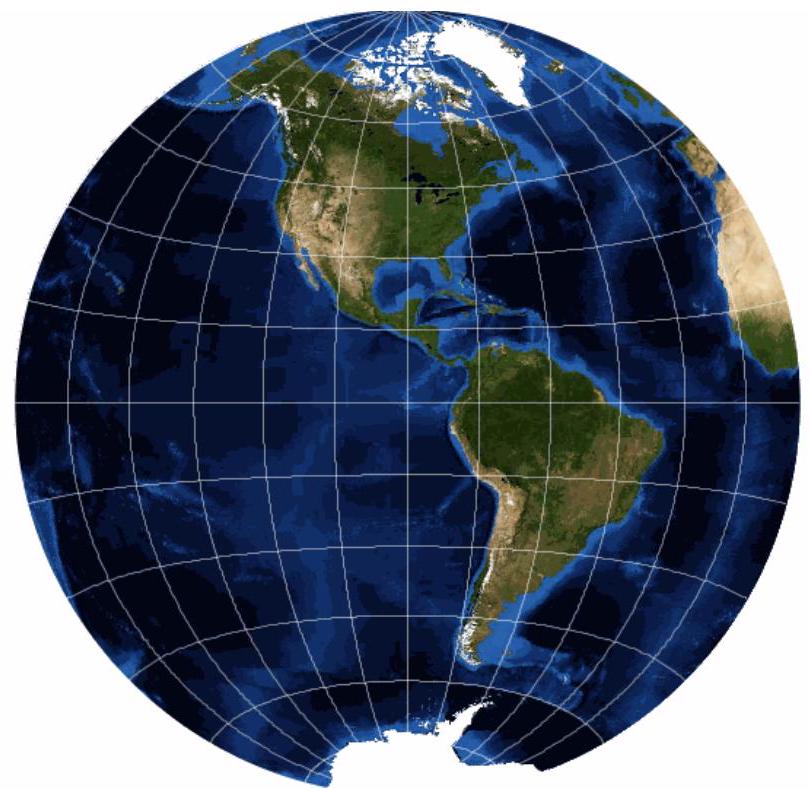
"If you were to describe the location of a place in your neighbourhood, what would you do? You would mention a landmark and then give directions with reference to that landmark. Similarly on the Earth's surface too, we use some fixed points and imaginary lines as references to help us locate various places."
1.0Introduction
- Our planet earth is not a sphere. It is slightly flattened at the North and the South Poles and bulge in the middle. In this chapter we are going to deal with various concepts related to globe like axis, equator, latitudes, longitudes and so on.
2.0Globe
- Globe is a true model (miniature form) of the earth.
- Globes may be of varying size and type - big ones, which cannot be carried easily, small pocket globes, and globe-like balloons, which can be inflated and are handy and carried with ease.
- The globe is not fixed. It can be rotated the same way as a top spin or a potter's wheel is rotated.
- On the globe, countries, continents and oceans are shown in their correct size.
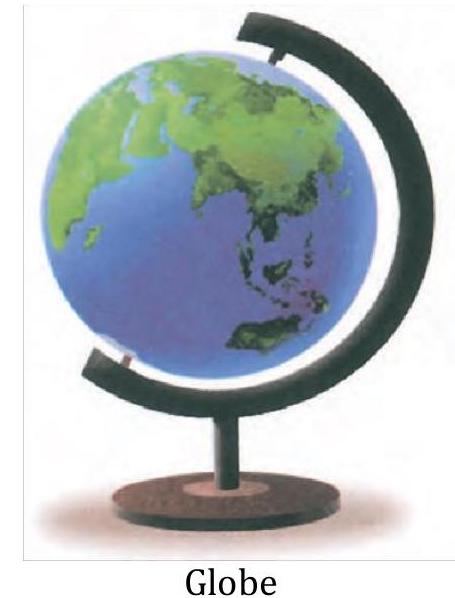
- It is difficult to describe the location of a point on a sphere like the earth. Now the question arises as to how to locate a place on it? We need certain points of reference and lines to find out the location of places.
3.0Axis
- You will notice that a needle is fixed through the glo be in a tilted manner, which is called its axis.
- Two points on the globe through which the needle passes are two poles - North Pole and South Pole.
- The globe can be moved around this needle from west to east just as the earth moves.
- But, remember there is a major difference. The real earth has no such needle.
- It moves around its axis, which is an imaginary line.
4.0Equator
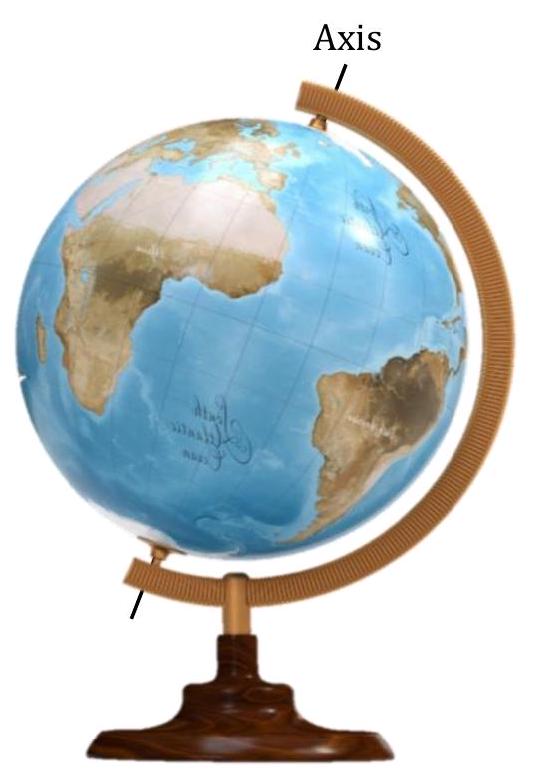
- Another imaginary line running on the globe divides it into two equal parts. This line is known as the equator.
- The northern half of the earth is known as the Northern Hemisphere and the southern half is known as the Southern Hemisphere.
- They are both equal halves. Therefore, the equator is an imaginary circular line and is a very important reference point to locate places on the earth.
5.0Latitudes
- All parallel circles from the equator up to the poles are called parallels of latitudes.
- Latitudes are measured in degrees.
- The equator represents the zero degree latitude.
- Since the distance from the equator to either of the poles is one-fourth of a circle round the earth, it will measure th of 360 degrees, i.e. .
- Thus, 90 degrees north latitude marks the North Pole and 90 degrees south latitude marks the South Pole.
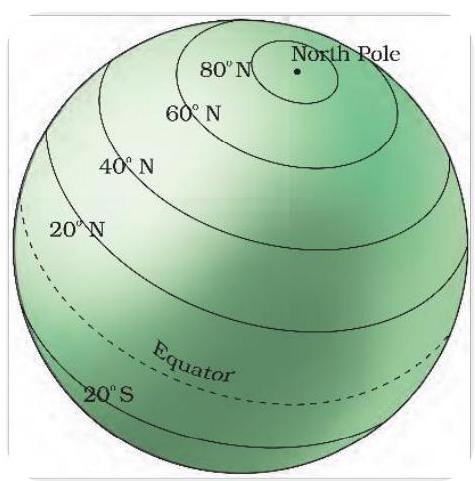
- As such, all parallels north of the equator are called 'north latitudes.' Similarly all parallels south of the equator are called 'south latitudes.'
- The value of each latitude is, therefore, followed by either the word north or south.
- Generally, this is indicated by the letter ' N ' or ' S '.
- For example, both Chandrapur in Maharashtra (India) and Belo Horizonte in Brazil (South America) are located on parallels of about latitude.
- But the former is north of the equator and the latter is south of it.
- We, therefore, say that Chandrapur is situated at latitude and Belo Horizonte is situated at latitude.
- We see in Figure that as we move away from the equator, the size of the parallels of latitude decreases.
Important Parallels of Latitudes
- Besides the equator , the North Pole and the South Pole ( ), there are four important parallels of latitudes- (i) Tropic of Cancer in the Northern Hemisphere. (ii) Tropic of Capricorn in the Southern Hemisphere. (iii) Arctic Circle at north of the equator. (iv) Antarctic Circle at south of the equator.
6.0Heat Zones of the Earth
- The mid-day sun is exactly overhead at least once a year on all latitudes in between the Tropic of Cancer and the Tropic of Capricorn.
- This area, therefore, receives the maximum heat and is called the Torrid Zone.
- The mid-day sun never shines overhead on any latitude beyond the Tropic of Cancer and the Tropic of Capricorn. The angle of the sun's rays goes on decreasing towards the poles.
- As such, the areas bounded by the Tropic of Cancer and the Arctic Circle in the Northern Hemisphere, and the Tropic of Capricorn and the Antarctic Circle in the Southern Hemisphere, have moderate temperatures. These are, therefore, called Temperate Zones.
- Areas lying between the Arctic Circle and the North Pole in the Northern Hemisphere and the Antarctic Circle and the South Pole in the Southern Hemisphere, are very cold.
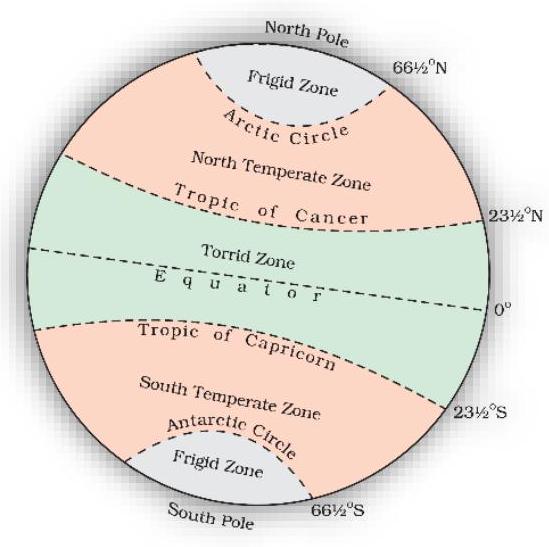


- It is because here the sun does not rise much above the horizon.
- Therefore, its rays are always slanting and provide less heat. These are, therefore, called Frigid Zones (very cold).
7.0What are Longitudes?
- To fix the position of a place, it is necessary to know something more than the latitude of that place.
- You can see, for example, that Tonga Islands (in the Pacific Ocean) and Mauritius Islands (in the Indian Ocean) are situated on the same latitude (i.e., ).
- Now, in order to locate them precisely, we must find out how far east or west these places are from a given line of reference running from the North Pole to the South Pole.
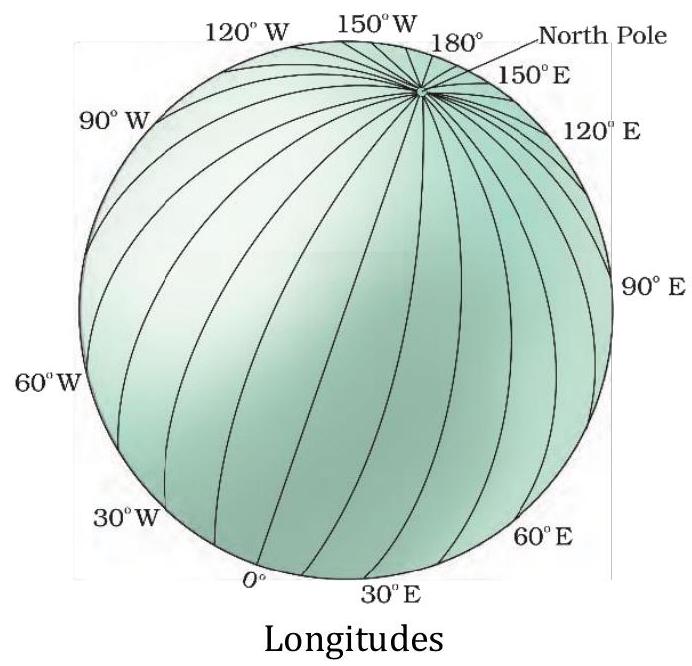
- These lines of references are called the meridians of longitude, and the distances between them are measured in 'degrees of longitude.'
- Each degree is further divided into minutes, and minutes into seconds.
- They are semicircles and the distance between them decreases steadily polewards until it becomes zero at the poles, where all the meridians meet.
- Unlike parallels of latitude, all meridians are of equal length. Thus, it was difficult to number the meridians.
- Hence, all countries decided that the count should begin from the meridian which passed through Greenwich, where the British Royal Observatory is located. This meridian is called the Prime Meridian.
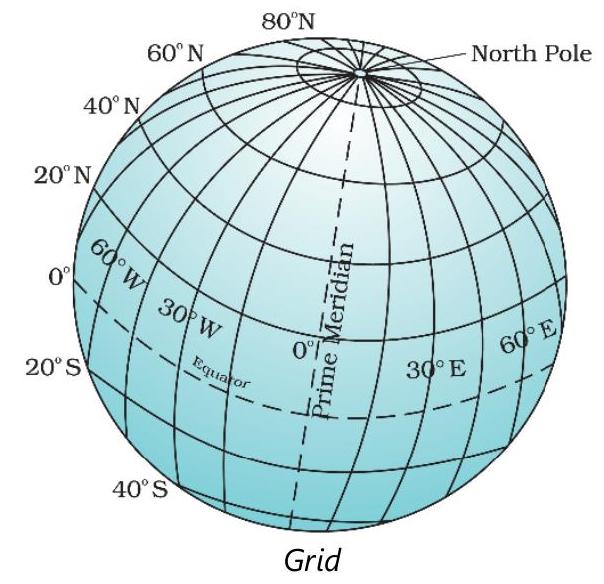
- Its value is longitude and from it we count eastward as well as westward.
- The Prime Meridian and meridian divide the earth into two equal halves, the Eastern Hemisphere and the Western Hemisphere.
- Therefore, the longitude of a place is followed by the letter E for the east and W for the west.
- It is, however, interesting to note that East and West meridians are on the same line.
- Now look at the grid of the parallels of latitude and meridians of longitude on the globe.
- You can locate any point on the globe very easily if you know its latitude and longitude.
- For example, Dhubri in Assam is situated at latitude and E longitude.
- Find out the point where these two lines cut each other. That point will be the location of Dhubri.
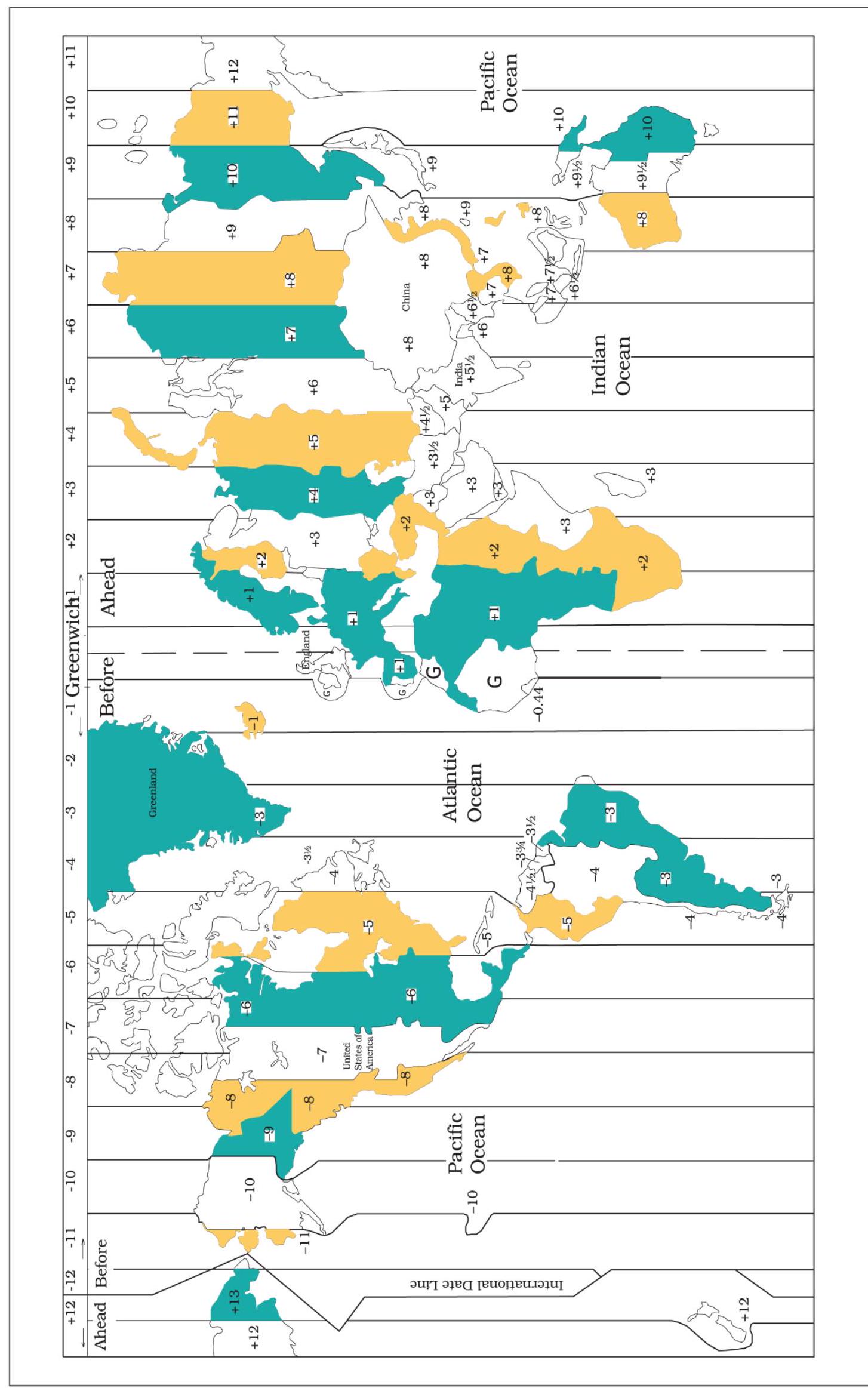
8.0Longitude and Time
- The best means of measuring time is by the movement of the earth, the moon and the planets.
- The sun regularly rises and sets every day, and naturally, it is the best time-keeper throughout the world.
- Local time can be reckoned by the shadow cast by the sun, which is the shortest at noon and longest at sunrise and sunset.
- When the Prime Meridian of Greenwich has the sun at the highest point in the sky, all the places along this meridian will have mid-day or noon.
- As the earth rotates from west to east, those places east of Greenwich will be ahead of Greenwich time and those to the west will be behind it.
- The rate of difference can be calculated as follows.
- The earth rotates in about 24 hours, which means an hour or in four minutes.
- Thus, when it is 12 noon at Greenwich, the time at east of Greenwich will be 60 minutes, i.e., 1 hour ahead of Greenwich time, which means 1 p.m.
- But at west of Greenwich, the time will be behind Greenwich time by one hour, i.e., it will be 11.00 a.m. Similarly, at , it will be midnight when it is 12 noon at Greenwich.
- At any place a watch can be adjusted to read 12 o'clock when the sun is at the highest point in the sky, i.e., when it is mid-day.
- The time shown by such a watch will give the local time for that place.
- You can see that all the places on a given meridian of longitude have the same local time.
9.0Why do we have standard time?
- The local time of places which are on different meridians are bound to differ.
- For example, it will be difficult to prepare a time-table for trains which cross several longitudes.
- In India, for instance, there will be a difference of about 1 hour and 45 minutes in the local times of Dwarka in Gujarat and Dibrugarh in Assam.
- It is, therefore, necessary to adopt the local time of some central meridian of a country as the standard time for the country.
- In India, the longitude of is treated as the standard meridian.
- The local time at this meridian is taken as the standard time for the whole country. It is known as the Indian Standard Time (IST).
Indian Standard Meridian
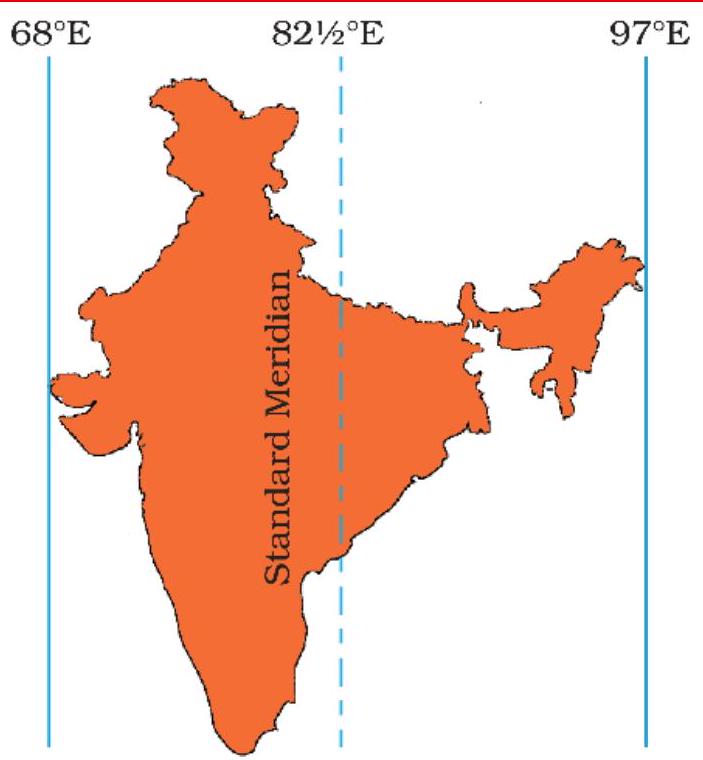
Kabeer lives in a small town near Bhopal. He tells his friend Alok that they will not be able to sleep tonight. A day and night cricket match between India and England had started at 2 p.m. in London. This means that the match would begin at 7.30 p.m. in India and finish well into the night. Do you know what is the time difference between India and England? India located east of Greenwich at E is 5 hours and 30 minutes ahead of GMT. So it will be 7:30 p.m. in India when it is 2:00 p.m. noon in London.
- Some countries have a great longitudinal extent and so they have adopted more than one standard time.
- For example, in Russia, there are as many as eleven standard times.
- The earth has been divided into twenty-four time zones of one hour each. Each zone thus covers of longitude.
10.0Glossary
- Bulge - A round lump that sticks out on something.
- Tropic of Cancer - It is the area from the equator which circles the earth, to the invisible line of the equator.
- Arctic Circle - It is the imaginary circle round the earth parallel to the equator at latitude ( ).
11.0MIND MAP
12.0Globe Latitudes & Longitudes
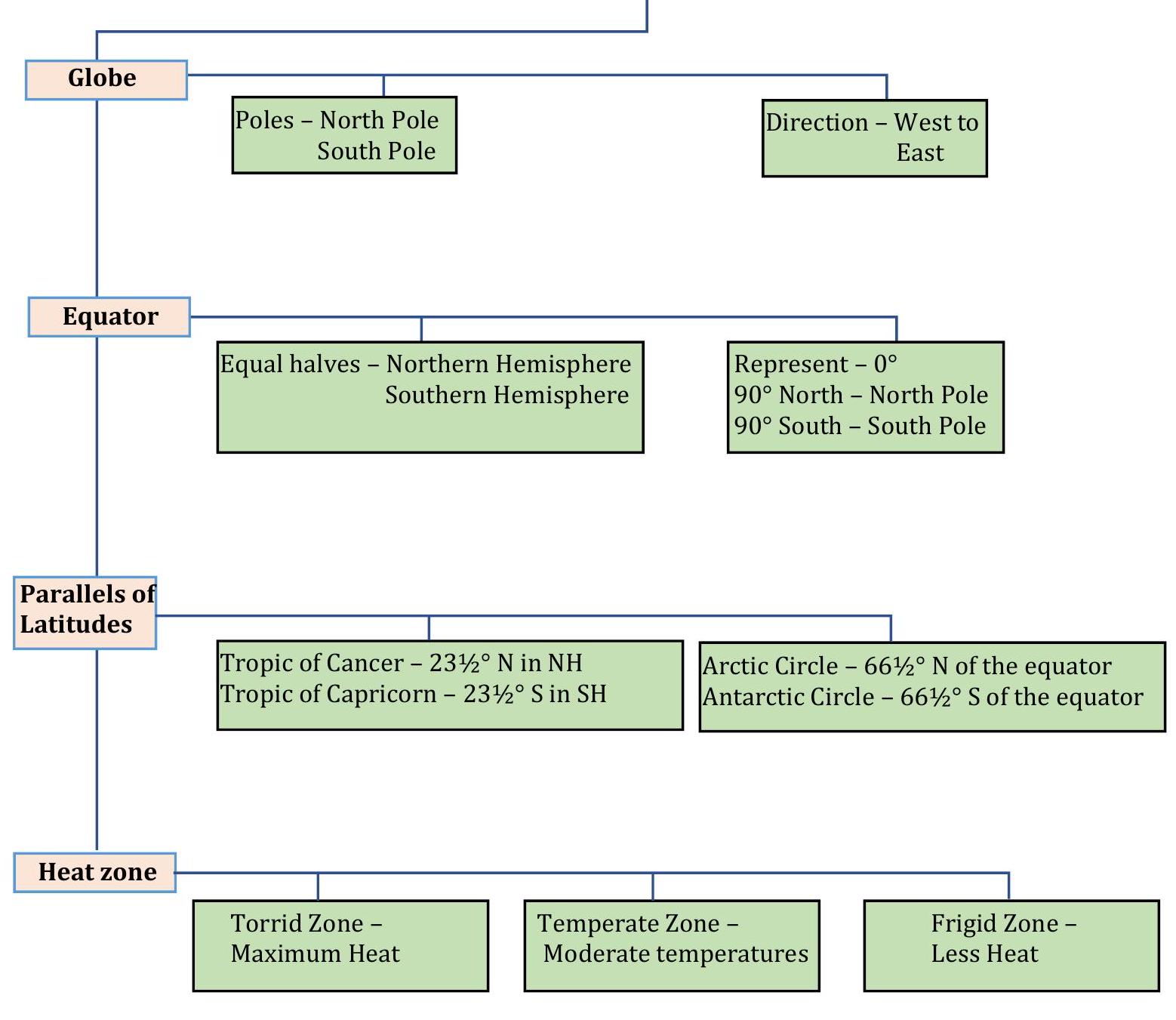
Related Article:-
Join ALLEN!
(Session 2026 - 27)